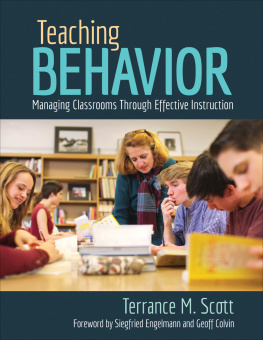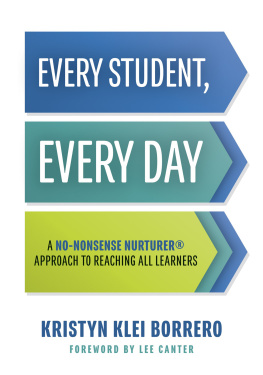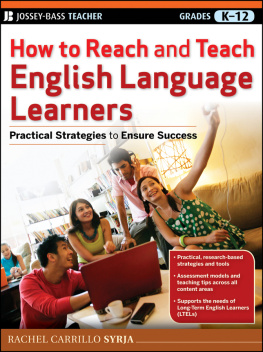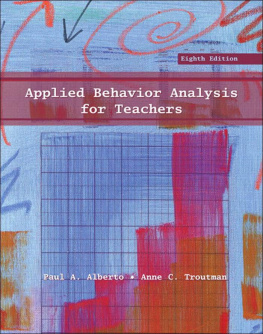


Copyright 2011, Prufrock Press Inc.
Edited by Lacy Compton
Layout design by Raquel Trevino
Author photograph reprinted with permission.
Copyright 2011 by Gretchen Johnson Photography.
ISBN-13: 978-1-61821-325-9
No part of this book may be reproduced, translated, stored in a retrieval system, or transmitted, in any form or by any means, electronic, mechanical, photocopying, microfilming, recording, or otherwise, without written permission from the publisher.
At the time of this book's publication, all facts and figures cited are the most current available. All telephone numbers, addresses, and website URLs are accurate and active. All publications, organizations, websites, and other resources exist as described in the book, and all have been verified. The author and Prufrock Press Inc. make no warranty or guarantee concerning the information and materials given out by organizations or content found at websites, and we are not responsible for any changes that occur after this book's publication. If you find an error, please contact Prufrock Press Inc.
 | Prufrock Press Inc. P.O. Box 8813 Waco, TX 76714-8813 Phone: (800) 998-2208 Fax: (800) 240-0333 http://www.prufrock.com |
Dedication
This book is dedicated to my students, who have taught me more than I could ever teach them.
Introduction
Virtually all teachers will encounter students who display problem behaviors in their classrooms. Positive behavior support (PBS) has evolved as the preeminent, research-based approach to help students with challenging behaviors to succeed in classroom settings. Educators across the country are embracing PBS as their primary means for student discipline, and a working knowledge of PBS is essential for classroom teachers to fully meet their students learning, behavioral, and social needs, and to fulfill requirements of state and federal mandates.
Preventing Challenging Behavior in Your Classroom: Positive Behavior Support and Effective Classroom Management targets regular and special education teachers who implement PBS in their classrooms. The book also serves as an essential resource for preservice teachers who are developing their classroom management skills. It focuses on practical strategies to prevent and reduce behavior problems and enhance student learning. Initial chapters overview the conceptual and empirical basis of PBS; however, much of the book describes PBS for inclusive settings, including techniques for students with and without disabilities. PBS interventions from peer-reviewed research are highlighted in easy-to-understand language to facilitate teachers knowledge of evidence-based techniques. Real-world examples are provided in conjunction with activities to enhance teachers understanding and mastery of the books content.
, What Is Positive Behavior Support?, presents a brief history and overview of PBS, including primary, secondary, and tertiary levels of prevention. The chapter provides a context for the books focus on classroom-level interventions.
, Myths and Facts About Effective Classroom Management, describes common misconceptions about classroom management, setting the stage for a discussion of effective interventions.
, The Foundation: Classroom Organization, discusses the keys to good classroom organization with real-world examples of organizational techniques.
, Active Student Responding to Prevent Challenging Behaviors, presents instructional techniques that encourage active student responding to reduce challenging behavior in the classroom. Strategies covered in this chapter include response cards, choral responding, guided notes, and brisk instructional pacing.
, Classroom-Wide Behavior Support, overviews basic principles of behavior and targeted strategies for students at risk for academic failure due to behavior problems.
, Functional Behavioral Assessment, targets students with chronic challenging behaviors. The chapter describes why students engage in problem behaviors and presents a continuum of strategies to assess behavior functions.
, Function-Based Interventions and Behavior Intervention Programming, discusses strategies for individualized interventions, with an emphasis on function-based supports and behavior intervention program development.
, Using Data to Evaluate PBS Outcomes, overviews the role of data in program evaluation, with techniques to collect and evaluate student data.
The last section of the book, Putting It Together: The Reflective Classroom Manager Survey, presents one strategy for assessing and improving the teachers implementation of effective classroom management techniques.
Each chapter begins with a set of chapter objectives. The reader should overview each objective to understand what he or she is expected to learn. Each chapter also contains a set of guided activities embedded throughout the text. It is useful to complete these activities while reading the text to enhance understanding of the chapters content. Finally, the last section contains the Reflective Classroom Manager Survey, which is designed to help in-service teachers reflect on their use of techniques described in the book and to develop an action plan for improving key strategies.
Chapter 1
What Is Positive Behavior Support?
Chapter Objectives
Describe the history of PBS.
Understand how PBS is part of the IEP process in special education.
Identify the critical features of PBS.
Describe the three levels of PBS intervention.
Describe the relationship between PBS and Response to Intervention.
In this chapter, we will overview the history of positive behavior support and its role within special education and behavior intervention programming. We will identify the critical features of PBS and explore school-based applications of each critical feature. Then, we will learn about primary, secondary, and tertiary prevention as core elements of PBS in schools. Finally, we will describe what PBS shares in common with Response to Intervention.
Ms. Ramirezs New Class
Ms. Ramirez is excited to begin her first year of teaching. She recently completed a teacher preparation program at a local university and has secured a position in an inclusive elementary school classroom. She is eager to organize her room, plan her lessons, and meet her students, but she is anxious about the challenges her first year of teaching will present. After reviewing her new students Individualized Education Programs (IEPs), she realizes that several of them have behavior intervention plans (BIPs) to reduce problem behaviors. Furthermore, the students BIPs include an unfamiliar term, positive behavior support (PBS). With this new information in mind, she wonders how she can best enable all of her students to be successful in school, including her students with challenging behaviors.
What Is Positive Behavior Support?
Positive Behavior Support and the IEP
As Ms. Ramirezs vignette illustrates, there is a lot of information for new teachers to learn. For instance, all students with disabilities who receive special education services have an IEP that describes their annual goals and short-term objectives, how their educational progress will be measured, and what accommodations and related services they will receive, in addition to other important information, in compliance with the Individuals with Disabilities Education Improvement Act of 2004 (IDEA). In essence, the IEP describes how a students special education program will be delivered and the manner in which the students educational progress will be evaluated.
Next page












